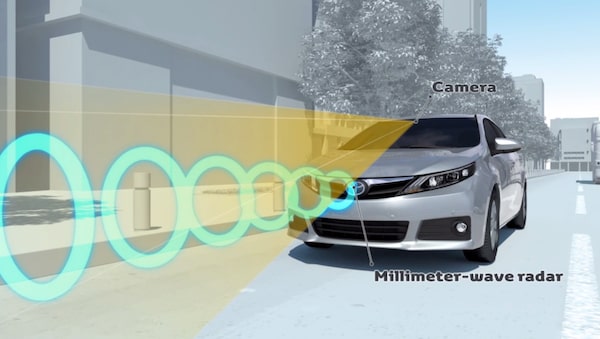
An illustration shows how Toyota Motor Group’s Pre-Collision System monitors the road ahead.Toyota
Automatic emergency braking – it’s a term that inspires either skepticism or overconfidence. The typical driver might be forgiven for thinking it can’t possibly work like it sounds or, conversely, that it’s capable of more than it really is.
Either way, car manufacturers are rapidly implementing AEB. It will be standard in all U.S. cars within a few years, which means Canada won’t be far behind.
So what exactly is AEB – how does it work and what is it for? Here’s an explainer of this rapidly proliferating technological safety feature.
What is it?
In a nutshell, AEB is an autonomous function that automatically applies the brakes when the car has determined a collision is likely.
In each case, the system at first provides warnings of an imminent crash, allowing the driver to intervene. If the driver fails to brake within a given amount of time, the car takes over and does so on its own.
Read more: Automated braking gets a real-life test on a busy Toronto on-ramp
How does it work?
The technologies involved vary depending on manufacturer, but most use some combination of camera and radar sensors to detect objects ahead of the car.
Such systems have been around for the better part of the past decade, starting generally in luxury brands before filtering more widely in recent years. For the most part, they are capable of detecting probable collisions with cars and pedestrians, although some are now adding other objects such as bicycles and baby strollers.
Toyota Motor Corp.’s Pre-Collision System, which the company says is now standard in 95 per cent of Canadian Toyota and Lexus models, is a good example of how these systems work.
The PCS features a millimetre-wave radar situated behind the car’s logo on its front grille, which detects the distances of objects in front of it. A camera mounted on the rear-view mirror, meanwhile, identifies exactly what those objects are.
Working together, the two sensors are able to discern cars and pedestrians and how far away they are. If they get too close and the car is moving quickly toward them, the AEB system kicks into the first of three phases.
In the first phase, the driver gets an audio and visual alert on their dashboard that a collision is likely. If the driver doesn’t start to brake, Phase 2 applies pressure to the anti-lock braking system. That way, the driver quickly gets some assistance when they do hit the brake.
If the driver still hasn’t taken action, the system goes into Phase 3 by applying brakes in an attempt to come to a full stop.
All of this happens within a few short seconds. In Toyota’s case, PCS works when the car is moving at least 10 kilometres an hour and up to its top speed in the case of collisions with other cars, or up to 80 km/h with pedestrians.
“We designed this system to solicit driver actions first,” says Hideki Hada, executive engineer in the electronics systems research and development division of Toyota Motor North America. “It’s the last resort in this PCS action.”
What is it for?
AEB systems are obviously intended to assist drivers in avoiding rear-end collisions. In cases where crashes can’t be completely avoided, the hope is that some applied braking will at least mitigate the speed of crashes and therefore the severity.
“It certainly does not replace a person, but it definitely assists them should they be distracted for a second,” says Terry Tizzard, manager of the Genesis Institute at Genesis Motors Canada, which offers AEB as standard on all models.
“A quick sneeze or a flash of light … obstacles pop up just that quickly. That’s where this feature really plays in.”
Automatic braking is also an integral part of the move toward self-driving cars, which is another reason manufacturers are pushing it.
“There are a number of systems that need to be in place to make that a reality and automatic emergency braking is one of those features,” says Shawn Stephens, national manager of after-sales systems for BMW Group Canada, which is making AEB a standard feature with the 2019 models.
What are the rules?
Regulators in North America aren’t yet requiring AEB as mandatory, but manufacturers are getting on board anyway.
In 2016, 20 auto makers representing about 99 per cent of new vehicles sales in North America agreed with the U.S. National Highway Traffic Safety Administration and the U.S.-based Insurance Institute for Highway Safety to make AEB standard by Sept. 1, 2022.
IIHS believes automated braking systems could prevent 9,000 collisions in the United States each year.
Petrina Gentile gets behind the wheel of BMW's top-of-the-line sedan that boasts level two autonomous driving features.
 Peter Nowak
Peter Nowak